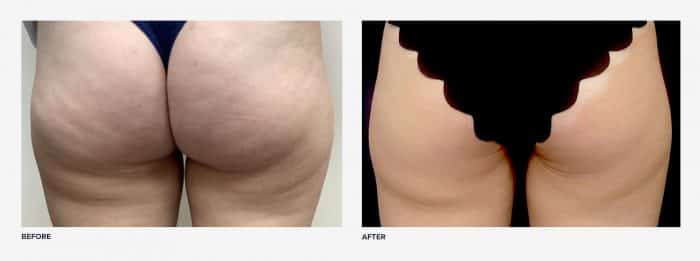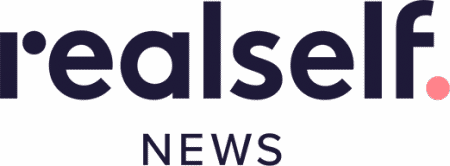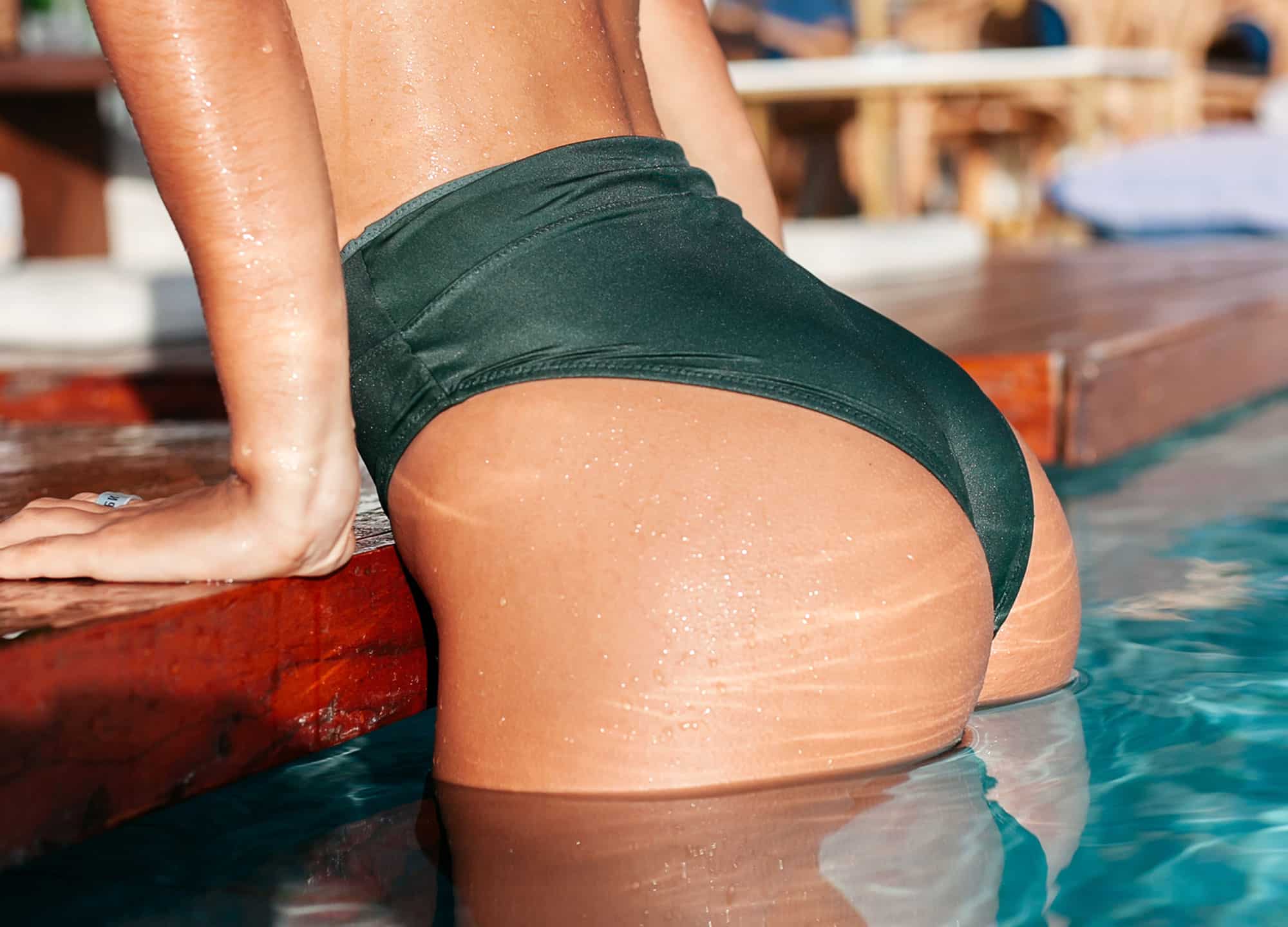Caitlin is a 28-year-old woman in New York City who got three Qwo treatments for cellulite and the “banana rolls” on her upper thighs. This is her experience, as told to Gabby Shacknai.
I’ve always led a very active lifestyle—from playing on sports teams as a kid to juggling Barry’s Bootcamp, SoulCycle, and Orange Theory classes as an adult—and it was with such regular exercise that I realized how much of my body was within my own control. Sure, maybe I’d gain a few pounds during the holidays or following a vacation, but I was always able to offset it quickly enough by getting back to my normal workouts.
The one thing I never seemed to be able to do anything about, however, was that stubborn section of fat at the top of my thighs and just below my buttocks. My “banana rolls,” as they’re so affectionately called, remained, regardless of how many squats I did or how much I avoided unhealthy foods, and they stuck out like a sore thumb against my legs, which have always been quite muscular. I grew increasingly self-conscious about these pockets of fat, especially in the summer months, when I wore bikinis. For years, I looked into possible solutions for these rolls but failed to find anything that was both effective and nonsurgical, so I assumed I’d simply have to make peace with them.
But toward the end of last summer, I came across some truly amazing news: the FDA had just approved Qwo, a new injectable to treat cellulite in the buttocks, including—*drum roll*—banana rolls. The more I read about the product, the more it seemed like the perfect solution for me. So when Qwo finally arrived at doctors’ offices this spring, I raced to be among the first to get it. I made an appointment with Dr. Bruce E. Katz, a board-certified dermatologist in New York City, and went in for my first appointment at the beginning of April, when he explained exactly how Qwo worked.
How Qwo works
“We know that these dimples we call cellulite are caused by fibrous bands that connect the skin to the underlying muscle,” Dr. Katz said. “They become stiff over time, and as they stiffen, they pull down on the skin and cause the dimples.” Qwo, he noted, is an enzyme that essentially destroys the collagen in these fibrous bands, but it addresses only collagen types I and II, which are in the bands but not in the surrounding tissue. “It’s very targeted in dissolving the fibrous bands, and it doesn’t affect nerves or blood vessels or the surrounding skin,” he added. “And once the fibrous bands are dissolved, the skin is now released and will gradually elevate again to the normal level rather than being a dimple or depressed.”
What my Qwo treatments were like
Dr. Katz started the treatment by marking the cellulite on my upper thighs; from there, I lay down on the operating table, and he injected each of those spots from three different angles. He told me that some patients find the injections to be slightly painful and said it was pretty akin to Botox or filler injections. I’ve always had a pretty high pain threshold and am never really bothered by injections, and these were no exception. While at times a bit uncomfortable, the Qwo injections were completely tolerable, and the whole thing was over within a matter of minutes.
When I asked about Qwo’s side effects, I was delighted to hear that there weren’t any major ones, but Dr. Katz did say to expect some pretty significant bruising. “The reason people get bruises is because there are blood vessels in those fibrous bands, so as you dissolve the fibrous bands, you’ll have bleeding from the blood vessels, since they’re being destroyed as well,” he noted. “But it’s not like the typical bruise you get from trauma—it’s just a very physiologic type of bruising, and we want that to happen, because it indicates that the fibrous bands are being destroyed.”

By the time I got home half an hour later, I could already spot some bruising, and it only worsened over the next few days. It was, quite honestly, some of the most intense bruising I’d ever experienced, but it was almost like my body was playing mind games on me, because the pain wasn’t at all proportional to the markings I saw on my upper thighs. Although there was a little tenderness the first day or two, which I noticed only when sitting on a hard surface, the area was pretty devoid of any actual pain. The bruising lightened after about a week and was completely gone less than two weeks after my treatment.
When I went back for my second Qwo session, three weeks later, and my third session, three weeks after that, the same process ensued, but I was given the helpful advice from Dr. Katz’s team to apply arnica gel on the area, to reduce bruising. I used the arnica on my thighs and lower buttocks for the four or five days that followed, and it seemed to make all the difference. While there was definitely still some bruising, it was far less significant than the first time around and went away more quickly.
My Qwo results

Dr. Katz told me I’d likely start to see a difference after my second Qwo treatment but that results would continue to improve up to three months after my final treatment. Although I’m still keeping a close eye on the area and am anticipating even further improvement, I’ve already noticed a huge change, just one month in. My banana rolls aren’t completely gone, but they are quite a bit smaller, and I swear it’s changed the look of my lower body—from behind, from the side, and even from the front.
The natural skeptic that I am, I was initially concerned that it would be just a matter of time until my upper-thigh cellulite reappeared, but Dr. Katz assured me this wouldn’t be the case. “We know that once these fibrous bands are dissolved, they can’t come back, because there’s no tissue there anymore,” he said, noting that patients from Qwo’s clinical trials had not seen their cellulite return even two and a half years after treatment. “It makes sense, because once you take away these bands, there’s no way they can form again. They were there from the get-go—people are born with them, so if you get rid of them, you can’t grow new bands.”
Similarly, Dr. Katz explained, the body would not compensate for these newly lost fibrous bands by creating cellulite where it never was. “It can only treat the areas we inject, but the fibrous bands develop over a period of years, and by removing them in one area, you won’t see cellulite develop in new areas that hadn’t been there before,” he said.
While I likely still have a little ways to go in terms of my full results, I’ve already been very impressed with Qwo’s abilities. I’m extremely happy with my decision to do the treatment, especially right before summer, and I would recommend it to anyone who has cellulite or banana rolls.











